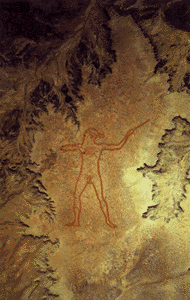 We’ve been making art intended for aerial viewing for thousands of years; there’s the Uffington White Horse from 1,000 BC, the Nazca lines, from 200 BC – 600 AD, and the Native Americanintaglios in the Southwestern US, for example. More recent geoglyphs also abound. The world’s largest is Marree Man, in Australia, made in 1998.
We’ve been making art intended for aerial viewing for thousands of years; there’s the Uffington White Horse from 1,000 BC, the Nazca lines, from 200 BC – 600 AD, and the Native Americanintaglios in the Southwestern US, for example. More recent geoglyphs also abound. The world’s largest is Marree Man, in Australia, made in 1998.
Until recently, these geoglyphs were intended for the gods or for the rare airplane overflight; now Google Earth users are discovering them in droves. Wherever the earth is a canvas for artistic expression, Google Earth is proving to be an ideal viewer.
My guess is that at this very moment there are plans afoot to take advantage of this newfound potential audience. Over the next three years, as satellite images are refreshed, I suspect we will see a boom in geoglyphs. Not just by artists, but also by advertisers, who will soon latch on to the idea that there is free advertising space to be had inside all the world’s mapping applications.
(Wikipedia definition of geoglyph. I’ve added Marree Man and the Nazca lines to my Tagzania feed.)
I found this page http://www.peruvian-tours.com/nazca_lines_google_earth.html , with coordinates of the Nazca Lines. it is possible to be seen the monkey, parrot, astronaut, spider, etc